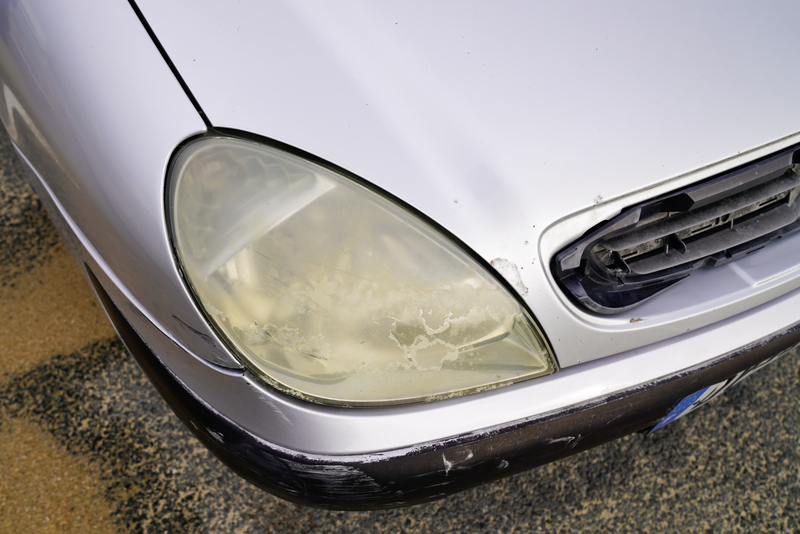No longer the brightest bulb on the block?

Headlights are one of the most important safety features on your vehicle. Yet, they also are one of the most neglected.
Headlights tend to become yellow or oxidize, especially when exposed to hot summer conditions. Bulbs fade as ad filaments become covered with carbon.
Light loss occurs so gradually that drivers may not notice until they are faced with unfamiliar terrain or foul weather.
The good news? Upgrading bulbs or repairing headlight lenses is a simple procedure.
"All lamps dim over time," said Alfred LaSpina, product marketing manager at Sylvania. "They should be replaced every two years to maintain the same optimum performance."
Up to 20 percent light loss within two years is not uncommon for drivers who log more than 30,000 miles, LaSpina said. Some of factors influencing bulb life and brightness include voltage, condition of the headlamp and road grime.
Light loss occurs so gradually that it goes unnoticed until drivers encounter foul weather or an unfamiliar road.
"Drivers can upgrade the lighting for their vehicles to see better and see further," LaSpina said. "The goal is to get as close to daylight as possible."
Premium headlight bulbs illuminate the road with more light and whiter color. Yet, basic automotive bulbs changed little for most of the past century.
Headlights originally contained a filament enclosed in glass tube and the coil cast light when heated by electricity—the same way household bulbs work.
Gas-filled tubes
In the 1980s, Halogen bulbs became a standard on most vehicles. They were brighter and lasted longer by heating filaments encased in a halogen-filled tube.
High performance Halogen bulbs offer a step up from standard Halogen bulbs. Improvements in coils, coatings and gas mixture give them up to 30 to 50 percent more light than standard Halogen bulbs, LaSpina said.
High Intensity Discharge bulbs, also known as Xenon, offer the brightest technology available. They do away with filaments entirely and generate an arc of light similar to a thunderbolt. They also draw less power and last longer than halogen alternatives.
According to the Motor Vehicle Lighting Council, HID light more closely resembles daylight than that produced by Halogen. It also emits up to three times more light on the road than standard Halogen bulbs and can last the life of the vehicle. Replacing standard headlight bulbs with HID bulbs may require changing the entire lamp fixture, however.
"There are always three things to consider when choosing the right bulb for your vehicle," LaSpina said. "The color of the light, its downroad and sideroad visibility, and bulb life."
LaSpina had the following information for drivers selecting and caring for their vehicle's lighting:
- Weighing quality versus expense. HID lights, also known as Xenon, are the most expensive but last the longest and emit the whitest light. If your vehicle uses Halogen lamps, switching to Xenon requires upgrading your vehicle's entire lamp fixture.
- Headlight restoration. Lens kits can improve clarity by reducing oxidation, yellowing and minor scratches. Ask your service advisor for suggestions on the safest way to polish headlights.
- High performance Halogen bulbs emit almost as much light as HID bulbs but have a shorter lifespan. Standard Halogen bulbs are the least expensive bulbs but have the longest lifespan and provide lower light output.
- Driving across mountains and the open road. Consider high performance Halogen bulbs or High Intensity Discharge bulbs that can cast more light over longer distances. They make it easier to see bends in the road or signs and animals along the shoulder.
- Cruising city streets. Ambient light from street lamps and businesses help with visibility but do not illuminate the path of your vehicle. Upgrading to high performance halogen can aid other drivers in seeing you.
- Upgrading for style. Halogen bulbs can mimic the kind of cool-blue accent found in Xenon lights. They are less expensive than their Xenon brethren but do not provide the same brightness.
- Maintaining clean lenses. Dirt and grime dramatically reduces visibility. Wash your headlights after driving in rain and snow.
- Aligning headlight beams. Are the cones of light coming from your cock-eyed? Ask your service advisor to check direction of the beams and make necessary adjustments.
- Replacing old bulbs. If your headlights are more than two years old, you may need to replace them. Headlights can lose as much as 10% of their brightness every year if you drive 15,000 miles or more a year.
- Going off road. Some types of bulbs are designed specifically for the brightness and heavy-duty requirements of off-road vehicles. These types of bulbs are not legal for street use. Check the product packaging for details.
"Choosing the right bulb for your vehicle is all about safety," LaSpina said. "As people get older they generally need better lighting for night driving. The ability to see something down the road allows you more time to react."